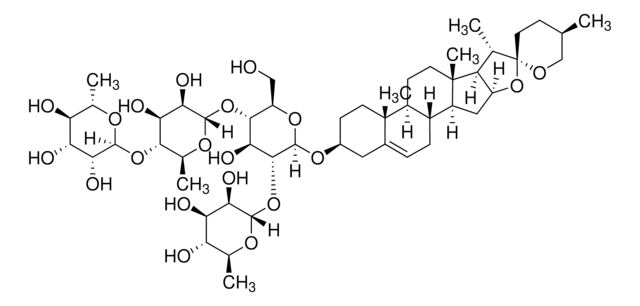If this product has an expiration or retest date, it will be shown on the Certificate of Analysis (COA, CofA). If there is no retest or expiration date listed on the product's COA, we do not have suitable stability data to determine a shelf life. For these products, the only date on the COA will be the release date; a retest, expiration, or use-by-date will not be displayed.
For all products, we recommend handling per defined conditions as printed in our product literature and website product descriptions. We recommend that products should be routinely inspected by customers to ensure they perform as expected.
For products without retest or expiration dates, our standard warranty of 1 year from the date of shipment is applicable.
For more information, please refer to the Product Dating Information document: https://www.sigmaaldrich.com/deepweb/assets/sigmaaldrich/marketing/global/documents/449/386/product-dating-information-mk.pdf
47036
Saponin
for molecular biology, used as non-ionic surfactant
Synonym(e):
Glycosides, Saponins
Größe auswählen
Größe auswählen
About This Item
Empfohlene Produkte
Qualität
for molecular biology
Qualitätsniveau
Mol-Gew.
1000-2000 g/mol
Zusammensetzung
Sapogenin, 8-25%
Methode(n)
HPLC: suitable
protein quantification: suitable
CMC
0.001-0.01%
Dichte
1.015-1.020 g/mL at 20 °C (5% in H2O)(lit.)
Fremdaktivität
DNase, RNase, Protease, Phosphatase, none detected
SMILES String
C[C@]1(CCC23COC4([C@H]2C1)CC[C@@H]5[C@]6(CC[C@@H](C(C6CC[C@]5([C@@]4(C[C@H]3O)C)C)(C)C)O[C@H]7[C@@H]([C@H]([C@H](CO7)O[C@H]8[C@@H]([C@H]([C@@H](CO8)O)O)O)O[C@@H]9[C@@H]([C@H]([C@@H]([C@H](O9)CO)O)O)O)O[C@H]1[C@@H]([C@H]([C@@H]([C@H](O1)CO)O)O)O[C@@H]1[C@@H]([C@H]([C@@H]([C@H](O1)CO)O)O)O)C)C=O
InChI
1S/C58H94O27/c1-52(2)29-7-11-55(5)30(8-12-58-31-15-53(3,22-62)13-14-57(31,23-77-58)32(64)16-56(55,58)6)54(29,4)10-9-33(52)82-50-46(85-51-45(40(71)37(68)27(19-61)80-51)84-49-43(74)39(70)36(67)26(18-60)79-49)44(83-48-42(73)38(69)35(66)25(17-59)78-48)28(21-76-50)81-47-41(72)34(65)24(63)20-75-47/h22,24-51,59-61,63-74H,7-21,23H2,1-6H3/t24-,25-,26-,27-,28+,29?,30-,31+,32-,33+,34+,35-,36-,37-,38+,39+,40+,41-,42-,43-,44+,45-,46-,47+,48-,49-,50+,51+,53-,54+,55-,56+,57?,58?/m1/s1
InChIKey
MAEBCGDGGATMSC-OSHGGGOQSA-N
Suchen Sie nach ähnlichen Produkten? Aufrufen Leitfaden zum Produktvergleich
Allgemeine Beschreibung
Anwendung
- in phosphatgepufferter Kochsalzlösung (PBS) zum Blockieren von Zellen für die Immunzytochemie und Konfokalmikroskopie
- zum Permeabilisieren von Zellen zum Messen der gesamten Mitochondrienmasse
- als interne Kontrolle zum Extrahieren von Saponin aus Holothuria nobilis Selenka
Biochem./physiol. Wirkung
Signalwort
Warning
H-Sätze
Gefahreneinstufungen
Eye Irrit. 2 - STOT SE 3
Zielorgane
Respiratory system
Lagerklassenschlüssel
11 - Combustible Solids
WGK
WGK 2
Flammpunkt (°F)
Not applicable
Flammpunkt (°C)
Not applicable
Persönliche Schutzausrüstung
dust mask type N95 (US), Eyeshields, Gloves
Hier finden Sie alle aktuellen Versionen:
Besitzen Sie dieses Produkt bereits?
In der Dokumentenbibliothek finden Sie die Dokumentation zu den Produkten, die Sie kürzlich erworben haben.
Kunden haben sich ebenfalls angesehen
-
How can I determine the shelf life / expiration / retest date of this product?
1 answer-
Helpful?
-
-
How is shipping temperature determined? And how is it related to the product storage temperature?
1 answer-
Products may be shipped at a different temperature than the recommended long-term storage temperature. If the product quality is sensitive to short-term exposure to conditions other than the recommended long-term storage, it will be shipped on wet or dry-ice. If the product quality is NOT affected by short-term exposure to conditions other than the recommended long-term storage, it will be shipped at ambient temperature. As shipping routes are configured for minimum transit times, shipping at ambient temperature helps control shipping costs for our customers. For more information, please refer to the Storage and Transport Conditions document: https://www.sigmaaldrich.com/deepweb/assets/sigmaaldrich/marketing/global/documents/316/622/storage-transport-conditions-mk.pdf
Helpful?
-
-
What is the source of the saponin?
1 answer-
This product is a plant sourced material.
Helpful?
-
-
What is the storage temperature for the product?
1 answer-
The product is stored in room temperature.
Helpful?
-
-
Hello. Please tell me the expiration date of saponin COA BCCH1923
1 answer-
This product does not contain an expiration date or recommended retest date. Products with no expiration date or recommended retest date should be routinely inspected by customers to ensure they perform as expected. These products are also subject to a one year warranty from the date of shipment. For more information you may access the "Product Dating Information" document under "ADDITIONAL USEFUL DOCUMENTS ABOUT OUR PRODUCTS" at the bottom of the Quality Services page with this link: https://www.sigmaaldrich.com/life-science/quality-and-regulatory-management/quality-services.
Helpful?
-
Active Filters
Unser Team von Wissenschaftlern verfügt über Erfahrung in allen Forschungsbereichen einschließlich Life Science, Materialwissenschaften, chemischer Synthese, Chromatographie, Analytik und vielen mehr..
Setzen Sie sich mit dem technischen Dienst in Verbindung.















